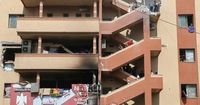The cost of reporting from Gaza and neighboring conflict zones continues to mount, with journalists and civilians alike facing unprecedented dangers. Over the weekend, the violence in the Gaza Strip claimed the life of yet another journalist, Mohammed al-Daya, whose death underscores both the personal and professional toll of this ongoing war.
According to the AhlulBayt News Agency, Mohammed al-Daya, a member of the Arabic social media department at the Palestinian Information Center (PIC), was killed on Saturday, September 27, 2025, when an Israeli warplane struck a tent on Abu Areef Street in Deir al-Balah, central Gaza. Local sources confirmed that al-Daya was inside the tent at the time of the strike. His death marks the third loss for the PIC during the current conflict, following the earlier deaths of Gaza bureau chief Dr. Rizq al-Gharabli and English-language social media head Dr. Refaat Al-Ar’eer.
In a statement, the PIC remembered al-Daya for his "dedication and persistence," emphasizing that he continued his reporting under constant threat, determined to document war crimes and share the suffering of civilians with the world. The organization did not mince words, calling his killing part of a "deliberate policy aimed at silencing Palestinian journalists and concealing the truth." The statement further described the deliberate targeting of journalists as a war crime and a desperate attempt to suppress the truth.
The Government Media Office (GMO) in Gaza echoed these sentiments, announcing that the number of Palestinian journalists killed by Israeli attacks since the start of the war nearly two years ago has now reached 252. The GMO condemned what it called a systematic campaign against journalists and called on the International Federation of Journalists, the Arab Journalists Union, and press organizations worldwide to denounce Israel’s actions. The GMO placed the blame not just on Israel, but also on the US administration and European countries, especially the United Kingdom, Germany, and France, holding them "fully responsible for what it described as 'heinous war crimes.'" The office urged international bodies to take serious steps to hold Israel accountable in international courts and intensify pressure to end the conflict and protect journalists in Gaza.
Al-Daya’s death is sadly not an isolated incident. Just last month, five journalists were killed in an Israeli strike on Nasser hospital in Gaza. A Reuters analysis, released on September 28, 2025, challenged Israel’s official explanation that the strike had targeted a Hamas camera. Using visual evidence and additional sources, Reuters concluded that the evidence contradicted Israel’s claim, raising further questions about the risks journalists face while covering the war and the transparency of military operations in the region.
The dangers for journalists are not confined to Gaza. The trauma and loss ripple far beyond its borders, as highlighted at the annual conference of the Middle East North Africa Trauma Alliance (MENATA) held in Dubai on September 29, 2025. Dr. Abeer Abdallah, a UAE resident, spoke movingly about losing her brother, Issam Abdallah, an award-winning Reuters journalist and filmmaker, who was killed in southern Lebanon in 2023. Issam was covering clashes between the Israeli Defense Forces and Hezbollah when an Israeli tank fired two 120mm rounds at a group of journalists, killing him and injuring six others.
“I'm older than him by just two years so we grew up almost like twins,” Dr. Abdallah recalled during the panel. “He was my best friend, my partner, my everything. Only recently with a lot of therapy, I have started to accept the reality that I cannot text him anymore. It is like a piece of my flesh is missing but I can still feel the pain, like a phantom limb.” She described the assignment that led to his death as routine, noting that “That day was just a casual day for him. He went to the south on a very safe town, so far away from the borders. It didn’t give me any notion that he’s in danger — not to me, not to his friends, not even to himself.”
Other journalists at the MENATA panel shared their own struggles with the psychological costs of reporting from war zones. BAFTA and Emmy-winning Gazan journalist Youssef Hammash, joining virtually from London, spoke candidly about the emotional toll of being far from his team on the ground in Gaza. “I know that after filming, my team has to stand in line for bread or water,” he said. “Recently, they were displaced from Gaza City to the south. I felt useless because I couldn’t support my own team on the ground, who are my old friends. The most painful part of it, to be honest, is the feeling of safety sitting in London when I know my counterparts are going through hell.”
Hammash explained that his job is both a responsibility and a coping mechanism, even as he deals with personal loss. “I'm alone. I have lost two of my homes and half my family, but we don't suffer from PTSD yet because we are still in the trauma itself,” he said. “We are taking it day by day...Otherwise, I think just witnessing what's going on in Gaza and that feeling of being useless will drive me mad.”
Syrian frontline reporter Mughira Al Sharif, an Emmy award winner, pointed out that journalists covering war and conflict zones often return home with “invisible scars,” which can manifest as PTSD, survivor’s guilt, and ongoing tension. “Rarely that the trauma stays with the journalist alone. Families feel it too. They live with constant anxiety. So, early professional support is absolutely critical in this situation,” he said, crediting his own manager at BBC for encouraging him to seek therapy after leaving Syria.
As the panel paid tribute to the more than 270 journalists and media workers killed by Israel since October 7, 2023, the mood was somber. The event ended with a standing ovation, many in the audience visibly moved by the stories shared.
The violence in Gaza shows no signs of abating. On Sunday, September 28, 2025, 57 Palestinian civilians were killed by Israeli army fire and bombardment, according to the Yemeni News Agency Saba. The attacks targeted homes, residential towers, displacement tents, and gatherings of civilians and aid seekers across the Strip, with a focus on the central sector. In Gaza City and the northern Strip, three Palestinians were killed near Palestine stadium, while others died in the Al Sabra neighborhood due to shelling and a detonated booby-trapped vehicle. The Al Aqsa Martyrs Hospital reported the death of 13-year-old Ahmed Mohammed Al Sharif from famine and malnutrition, a stark reminder of the humanitarian crisis gripping the region.
In the central sector, an airstrike killed 13 Palestinians near the David Mosque in Al Nuseirat, while other deaths were reported in Al Hasaina, Al Bureij camp, Al Maghraqa area, and southern Gaza near aid distribution centers. Local sources described the ongoing violence as part of a "genocide crime and starvation war" that has persisted for nearly two years.
As the toll mounts, so too does the urgency for international action to protect journalists and civilians alike. The stories of those lost and those who continue to risk their lives to document the conflict serve as a stark reminder: the pursuit of truth in war comes at a profound—and often deadly—cost.


